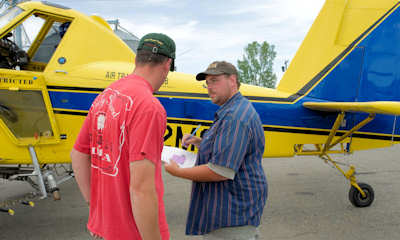
Things move fast on the farm and in the fields all summer long. Farmers have a lot on their plates and must keep several irons in the fire all at once. The same is true for custom applicators who help farmers nurture and protect their crops.
It is easy during the busy times to assume your custom applicator understands your instructions exactly. But failing to communicate properly with custom applicators, and failing to give them accurate, reliable information could result in big problems. Several Nebraska Extension educators offer the following recommendations for farmers to help their custom applicators do the best job possible.

When working with custom applicators, make sure you communicate clear instructions on product to be sprayed and field locations. (USDA photo)
1. Get the directions to the field right. Provide GPS coordinates if possible. “Location is vitally important,” says Nebraska Extension educator Keith Jarvi. “Nothing is worse than spraying the wrong product in the wrong field, so a hard copy of directions to the field is good to have for both the producers and the applicator, even if it is just an email.” Besides, applicators spraying restricted use pesticides are required to save that information. When you are giving narrative directions to the applicator, make sure they understand landmarks you might refer to. Make detailed directions and ask yourself when reading them back if you were in the applicator�’s shoes, would you understand what they meant.
2. Plan ahead and give plenty of lead time. “In the case of insect and possibly disease infestations, things can happen fast and sometimes, if there is a long backlog, the applicator should let the farmer know when they can make it,” Jarvi explains. “Since the damage is sometimes over before the application can be made, this is crucial.” Jarvi says that it works best if the farmer or the farmer’s crop consultant understands the life cycle of the pests involved. That way they know when it will be too late to have a positive economic effect when spraying. They can give this “drop dead date” to the applicator, so they understand the importance of the timing of the treatment.
3. Let applicators know about sensitive crops. Check out driftwatch.org and let applicators know of any sensitive targets in the area to be aware of in your fields or on neighboring property, suggests Nebraska Extension educator Jennifer Rees. “Examples might include grapes, organic fields, beehives and other sensitive crops nearby. Be sure to consider wind speed and direction,” Rees says.
4. Make detailed planting records and check them twice. In the rush of planting last-minute changes must be made - the grower ran out of seed, or weather r delayed planting, for example. Make sure what actually happens gets recorded. These small changes can cause issues for applicators unless they are given detailed instructions ahead of time.
“Double check the seed label before planting and keep perfect records of what is planted where,” suggests Nebraska Extension educator Nathan Mueller. “Utilize new as-planted maps or keep good notes of where each variety or hybrid is planted on the farm.”
5. New traits and conventional varieties keep it interesting. “The release and planting of crops with new herbicide-resistant genetic traits, like Enlist or Xtend, and also a trend in planting conventional products, will make internal communication between staff at agribusinesses even more critical,” Mueller says. “This will require more awareness of appropriate nozzles, extra steps when changing products, buffers and sensitive plants nearby.” Some custom applicator businesses and growers will most likely designate a separate sprayer for some products during specific times of the year.
Sit down with the applicator to re-emphasize fields planted to these new traits or conventional seed, so major mistakes can be avoided and growers will get the most effective weed control. If possible, generate color-coded field maps to easily show where varieties and hybrids with specific herbicide-resistant traits are planted on the farm to provide to your custom applicator.
6. Have a backup plan. Discuss backup plans in your herbicide program created from long rain delays during both the planting season and later in the season during post-emergence applications, Mueller says. Talk about what products may need to be switched and how rates, carrier, adjuvants and surfactants may also need to be adjusted if treatments are delayed.
- Arens writes for sister publication Nebraska Farmer
About the Author(s)
You May Also Like




